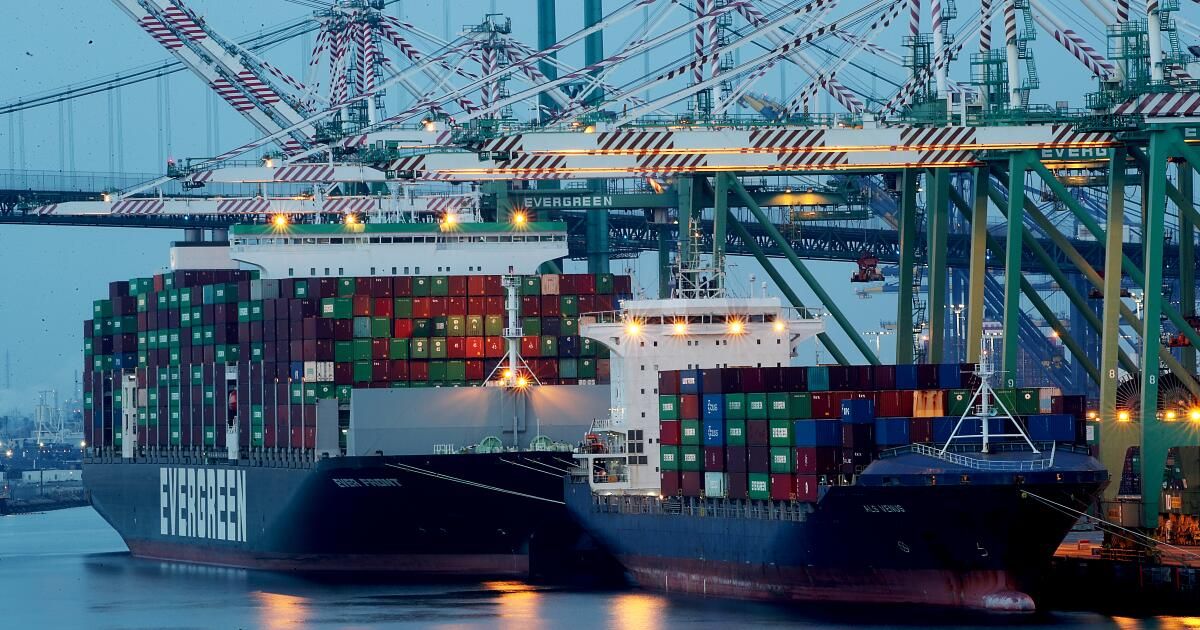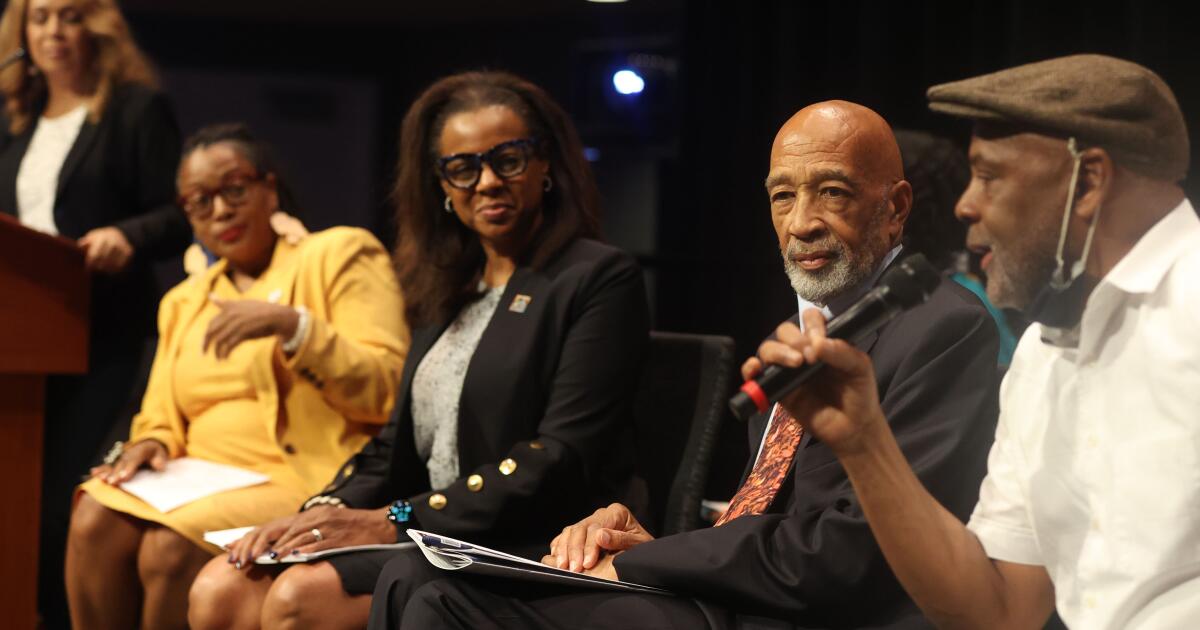The morning on the San Pedro docks began in typical summery but cool fashion as the first shift got the Port of Los Angeles up and running. The giant cranes that fill the sky like skeletal bridges came to life. Semi-trucks were already lined up at the entry gates, ready to receive loads of cargo containers as big as mobile homes.
But shortly after 7 a.m., an all-too-familiar problem struck. A power line glitch, so short it barely registered on monitors at the Los Angeles Department of Water and Power, abruptly halted major operations at the busiest seaport in the Western Hemisphere.
If the public face of the port is the forest of cranes and the mountain range of cargo containers, its invisible heart is a network of computers that controls nearly the entire operation. That system, along with a growing multitude of electric equipment and vehicles, depends on an uninterrupted supply of electricity. Restarting all those smart devices, sometimes requiring workers to climb atop 200-foot cranes, can take several hours, no matter how brief the power outage.
When everything was back up and running that August morning, unloading schedules were scrambled, frustrated terminal operators were struggling to make up for lost time, and the highway was clogged with dozens of semitrailers.
“It’s a significant direct financial impact,” said Jeff Vogel, general counsel for the National Coastal Employers Association, whose members include container handling companies. “We operate on a just-in-time economic model, where it’s critical to get the vessel in and out of port as quickly as possible.”
And the impact of power disruptions goes beyond immediate costs and frustration: It threatens the commitment to meet long-term climate change goals by electrifying port operations and the vast distribution system they serve.
The brief surge was one of three this month and the 12th power outage of the year so far. And the recent disruptions were especially hard hit because summer is a busy season for ports, with back-to-school and Halloween deliveries as well as retailers getting ahead of holiday shipments. The Port of Los Angeles had a record July, with more than 939,000 containers moving.
“It's a very important issue given the amount of cargo they have to move,” said Thomas Jelenić, vice president of the Pacific Merchant Shipping Association, which represents terminal operators.
In the future, the agreement will be even more important. The port, together with the DWP, aims to phase out greenhouse gas emissions by the end of the decade.
To meet this target, the port will need almost twice as much power as it currently uses by the end of the decade, according to DWP estimates. But the spikes and dips have raised serious questions about whether the port and its tenants will have reliable power to meet their needs.
Private companies that operate container-handling terminals long ago electrified massive ship-to-shore cranes and are now investing millions to transition to forklifts, gantry cranes and yard tractors that move and stack containers, as well as other vehicles and equipment that run primarily on diesel.
Container ships docked at the Port of Los Angeles.
(Luis Sinco/Los Angeles Times)
“We’re facing a mandate of zero emissions by 2030, and I don’t know how that’s going to be achieved right now,” said one terminal executive who asked not to be identified. None of the seven container terminals at the Port of Los Angeles spoke publicly about their complaints, saying they were concerned about how city officials, which are their landlords and energy providers, might react.
While the Port of Los Angeles and its sister facility in Long Beach are leading the way, other seaports around the country have also been taking steps to electrify their operations. That has put more demand on the grid, and occasional power outages have been reported at some ports on the East and Gulf coasts, said Vogel of Waterfront Employers.
But the problem appears to be particularly acute at the Port of Los Angeles, he said.
At the Port of Long Beach, where electricity is supplied by investor-owned Southern California Edison, terminal operators say power outages have not been a problem. In fact, Sean Gamette, the port's managing director of engineering, could not recall a single power outage this year.
That's helped by the fact that Southern California Edison's lines are mostly underground and that the port, considered vital infrastructure, is free of rolling blackouts, or power outages that result from a temporary drop in voltage. About $180 million was invested in the mid-2000s to upgrade the port's electrical infrastructure, Gamette said.
Gene Seroka, executive director of the Port of Los Angeles, was careful not to overstate or downplay the disruptions and the threat to operations. Power surges tend to affect only a few of the terminals, he said, and everything typically restarts within a couple of hours. If there is one brief power outage a month on average, that could represent the loss of one shift out of 36, Seroka said.
“I don’t think this is closing this port. It’s not affecting competitiveness terribly,” he added, but added: “If I’m a terminal operator and I have to pay workers for a shift that they’re not working, that’s very painful. And we have to fix that.”
The problem is not just financial. Power outages also pose safety risks. At one terminal, a power surge in mid-July caused a driverless cargo truck to crash into a container. “A crane operator can be forced to stop violently and be pushed,” said another terminal manager.
Terminal operators say they believe the source of the outages is the utility and have questioned whether the DWP has even recorded the momentary outages that cause costly delays at the docks.
DWP officials say this is not a one-sided problem and, at The Times’ request, provided a synopsis of the dozen power outages this year. The utility said two were due to birds striking power lines, one was caused by a truck exploding and another was because an electrical transformer failed.
But according to the account provided to The Times, in five power cuts, each lasting 10 seconds, no cause was found. Simon Zewdu, a senior manager in the DWP's electricity system, said such momentary outages were usually due to a problem on the customer's side.
“We are increasingly seeing equipment installed by our customers that is very sensitive to small voltage fluctuations,” he said.
Zewdu said the DWP is working to expand substations at the Port of Los Angeles and build new underground lines as part of a $500 million project to be completed by 2029. These efforts should help add power and improve reliability.
Additionally, Zewdu and the Pacific Merchant Shipping Association began a new round of meetings this week to discuss strategies to mitigate power outages and toward their zero-emissions goal. Among other things, Zewdu said he wants to install monitoring equipment on circuits on both the utility and terminal sides to discern the source of power surges — something he said has not yet been done because terminal operators have not submitted an application or given permission to the DWP’s power quality monitoring equipment.
Jelenić, of the Pacific Shipping Group, said that until Monday he was not even aware that a monitoring programme existed at the DWP.
“We are currently short on both our short-term and long-term needs,” she said, but added that her group had a very encouraging meeting with DWP officials this week. “They were concerned about the problems we are having, proposed solutions and established clear and open lines of communication.”











